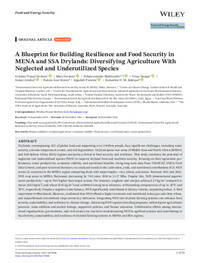A Blueprint for Building Resilience and Food Security in MENA and SSA Drylands: Diversifying Agriculture With Neglected and Underutilized Species

Authors:
Drylands, encompassing 41% of global land and supporting over 2 billion people, face significant challenges, including water scarcity, extreme temperatures, and soil degradation. Dryland spans vast areas of Middle East and North Africa (MENA) and Sub-Sahara Africa (SSA) regions and poses a threat to food security and resilience. This study examines the potential of neglected and underutilized species (NUS) to improve dryland food and nutrition security, focusing on their agronomic performance, water productivity, economic viability, and nutritional benefits. Using long-term data from FAOSTAT, USDA Food Data Central, and peer-reviewed literature, we analyzed trends in the cultivation, yield, and nutritional contributions of 26 NUS across 22 countries in the MENA region comparing them with major staples—rice, wheat, and maize. Between 1961 and 2022, NUS crop areas in MENA fluctuated, decreasing by 7.0% since 2018 to 21.17 Mha. Despite this, NUS demonstrated superior water productivity—up to 30% higher than major cereals. For instance, sorghum and cowpea achieved 2.5 kg/m3 compared to maize (0.83 kg/m3) and wheat (0.91 kg/m3) and exhibited strong heat tolerance, withstanding temperatures of up to 42°C and 38°C, respectively. Despite a negative trade balance, NUS significantly contributed to dietary calories, surpassing wheat. A field experiment in Merchouch, Morocco, confirmed that NUS offered a higher economic value per unit than wheat, and outperformed conventional crops across key indicators. Integrating NUS into dryland farming systems can enhance food security, sustainability, and resilience to climate change. Advancing NUS requires breeding programs, tailored good agricultural practices, value addition and market linkage, supportive policies, and farmer education. Collaborative efforts among international organizations, governments, and civil society are crucial to mainstreaming NUS in agrifood systems and contributing to the diversity, sustainability, and resilience of dryland farming systems in MENA and SSA regions.
